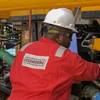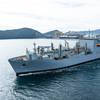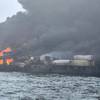Linking Fast Ferries into the Public Transport Network
Located along the mid coast of the Northeast U.S., New London, Conn. has long been a center for ferry transportation dating back to the early days of passenger travel via sailing schooner, steamship and rail ferries. New London's naturally sheltered, deep water harbor allowed it to develop into a major marine travel hub and established it as a major stopping point between the metropolitan areas of New York City and Boston.
Confronted by an ever-growing population, an increase in highway congestion and related pollution from emissions, and continued reliance on automobile travel, New London, with its unique geographic location and accessibility to multiple modes of transport, finds itself in the transportation forefront once again. The development of a true intermodal transportation center, focusing on the creation of a high-speed ferry hub linking the city with various visitor destinations, is of key importance to relieving the highway congestion faced by travelers in the populated Northeast corridor of the U.S.
Intermodal Transportation
The term "intermodal transportation center" has developed a broad range of definitions. In the strictest of terms it can refer to a simple commuter rail station with an Amtrak terminal. In a broader sense, it refers to complex structures with varying combinations of commuter and light rail, local and regional bus lines, shuttles, taxis, and parking structures. In the ideal sense, it also includes centers built around or with connections to airports, including local air and ferry services.
Regardless of which definition is used, a well designed and located ferry terminal can form the cornerstone of an intermodal transportation center.
While the development of a national policy towards the development of intermodal transportation centers in the U.S. may still be in the near future, some states and private initiatives have begun to develop centers where intermodal travel may occur. The Intermodal Surface Transportation Efficiency Act (ISTEA) has laid the foundation for various intermodal facility projects throughout the country through the awarding of funds to municipalities working alone or in conjunction with private enterprise.
There are examples of intermodal transportation systems in the U.S. that include seamless links to ferry services. New York Waterway's ferry service between New Jersey and Manhattan offers a one-price ticket providing the rider with a ferry and bus connection at the ferry terminal. Another system where ferry service is linked with other forms of mass transportation is the one currently operating in the San Francisco Bay area where high-speed ferries offer connections to a transit bus system and the BART (Bay Area Rapid Transit) system.
Linking Ferry Service
Cross Sound Ferry Services, Inc. operates conventional vehicle ferries and a high-speed, passenger-only ferry between New London and Orient Point, Long Island, N.Y. Primarily a vehicle-carrying ferry service, Cross Sound Ferry also began to see an increase in passenger-only ridership in 1994 originating from Long Island due to the expanding tourism base in the Southeastern Connecticut region.
The company looked for ways to promote its high-speed service along with the conventional auto-ferry service to those who may be commuting via rail on Amtrak's Northeast Corridor route between New York and Boston. The linking of railroad and ferry passengers in New London was logical and simple because the train station is directly adjacent to Cross Sound's ferry terminal. Cross Sound and Amtrak entered into a joint-ticketing agreement whereby a passenger could purchase a combination rail/ferry ticket at any of Amtrak's Northeast Corridor rail stations.
On Long Island, Cross Sound Ferry entered into an agreement with the Metropolitan Transit Authority's Long Island Rail Road to offer travelers from Long Island a rail/bus/ferry connection to New England through a combination ticket package. This package provided a transfer of passengers from all LIRR stations originating from New York's Penn Station to its hub in Ronkonkoma and on to Greenport where travelers were met by bus service for the eight mile trip to Orient Point to meet the fast ferry Sea Jet I service.
Upon arriving in New London, passengers were afforded the choice of bus service to Southeastern Connecticut tourist destinations, or there was an option to continue by rail on Amtrak.
Multi-Operator High-Speed Ferry Terminal
The concept behind the multi-operator, high-speed terminal is to attract operators of high-speed ferry services who would benefit from a terminal in this ideal port location with its convenient access to other modes of transport, and whose service routes proved viable due to the travel savings as compared to existing options.
The terminal facility in New London, linked with high-speed and conventional rail service (Amtrak), commuter rail service (Shoreline East), interstate bus service (Greyhound), regional bus service (SEAT), the 1,000 space Water Street parking garage, taxi and limousine service to two major airports, Interstates 95, 395, and Route 2 from Hartford, and existing complementary ferry services, affords the traveler numerous options for connections to their eventual destinations.
The facility is modeled after successful ferry terminal designs in Europe and Asia. The design will provide enclosed connections from the surrounding transportation modes to the ferry loading ramps; affording the traveler a sheltered, seamless link in transportation. The multi-operator, high speed ferry terminal facility consists of the following components: four berths for the mooring and loading of high speed ferries, the terminal building housing passenger waiting area, ticket counters, bathrooms and other traveler amenities, the overhead pedestrian walkway and elevator tower connecting the terminal building to the Amtrak rail road station and the public parking garage, a public observation deck above the terminal building, and a vehicle loading area for cars, busses, taxies, shuttle vans, delivery trucks and service vehicles.
An $800,000 federal grant through the Ferry Boat Discretionary Program, awarded to the city of New London in October, 1999, was specifically allocated for use for he construction of the covered waiting area and for the pedestrian walkway and plaza.
In 1996, the City of New London in conjunction with Cross Sound Ferry and Amtrak received a $1.6 million grant through the ISTEA program for the construction of a pedestrian bridge linking the 1,000 space Water Street parking garage to the Amtrak station, Greyhound Bus terminal, regional transit bus system, and Cross Sound Ferry's terminal. After receiving the grant, Amtrak decided to advance the project by announcing plans for a new railroad station elevated over the tracks connecting to the new pedestrian bridge from the parking garage.
With the completion of the electrification of the Northeast Corridor line by Amtrak, along with the high level platforms that were built, the work on the crosswalk was able to commence.
Existing and Potential Routes
The ferry terminal has the potential to serve as the terminus to over a dozen high speed ferry routes. Presently, New London serves as the terminus to three conventional (slow speed) ferry routes from Block Island, R.I.; Fishers Island, N.Y.; and Orient Point, N.Y.. New London also serves as the home port to three high speed ferry routes from Orient Point, N.Y.; Liberty Park, N.J.; and seasonal service to Martha's Vineyard, a popular island destination.
The proposed multi-operator high speed ferry terminal would enable the consolidation of high speed ferry operations serving these destinations at one central facility.
Because New London is surrounded by popular island destinations and coastal communities, there are a number of routes which may be suitable for high speed ferry service. An analysis of travel times to these popular surrounding destinations using vehicle transportation and existing vehicle ferries compared to the potential high speed ferry travel time indicates which new routes are candidates for high speed ferry service from the New London Intermodal Transportation Center. The results of this analysis indicate there are seven feasible routes to popular destinations not presently served by high speed ferries. Table 1 contains a listing of both existing and potential high speed ferry routes and their associated travel time savings.
Table 1
Existing and potential high speed ferry routes
Travel time savings from New London
Destination Travel time (existing) Travel time (using high speed ferry) Time savings
East Hampton, N.Y. 6 hours 1 hour 5 hours
Orient Point, N.Y. 5 hours 0.8 hours 4.2 hours
Glen Cove, New York 4.5 hours 2 hours * 2.5 hours
Block Island, R.I. 3 hours 1.2 hours 1.8 hours
Newport, R.I. 1.8 hours 1.3 hours * 0.5 hours
Woods Hole, Mass. 2.5 hours 1.9 hours * 0.6 hours
Martha's Vineyard, Mass. 5 hours 2 hours * 3 hours
Nantucket, Mass. 7 hours 2.3 hours * 4.7 hours
Notes: Times include average traffic delays Times calculated for 30 kt. ferry unless marked.
*Indicates 45 kt. Ferry
Intermodal Travel
The intermodal transportation center in will allow travelers to reach these new high speed ferry destinations using multiple modes of mass transportation, most notably Amtrak's high speed rail service.
For example, a person leaving New York City on a Friday and traveling to Martha's Vineyard for a summer weekend vacation will be able to board a high speed train at Penn Station in New York City and reach New London in under two hours. The traveler will then be able to board a high speed ferry, seamlessly transferring without ever having to step outside, and in two hours arrive at Martha's Vineyard. Allowing for boarding and transfer times, this entire trip could easily be completed in about four hours.
At present, a traveler driving from New York City to Cape Cod, and then connecting to existing ferries to Martha's Vineyard on a summer weekend, can realistically expect the journey to take over eight hours.
Stanley W. Mickus has been employed by Cross Sound Ferry Services in New London, Conn. since 1992 as the company's director of marketing and public relations. Adam Wronowski, marine engineer and vice-president of the Wronowski Marine Companies Group, represents the third generation of the Wronowski family involved in the marine industry spanning over 50 years of experience in the business. Dr. Clifford R. Bragdon is the director of the National Aviation and Transportation Center at Dowling College.








